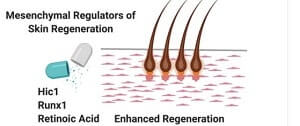Is this quote comparing inhibition of fgfr5 to inhibition of fgfr1&2 or inhibition of fgfr1&2&5?
FGF5 ablation vs FGFR1/2
Is this quote comparing inhibition of fgfr5 to inhibition of fgfr1&2 or inhibition of fgfr1&2&5?
Seeing you know mustang why dont you try topical duta instead of finasteride? finasteride will be guaranteed to go systemic whereas many avoid that on topical duta 1x/week.Hey @Mustang how do you feel about all this? Read OP and let us know. Considering you have access to a lab 24/7 for next to nothing, maybe you would be down to try some of this stuff and report back with blood work to monitor possible systemic absorbtion + scalp biopsys etc..???
Could SM04554 potentially be strong enough to provide long term maintenance you think?AFAIK SM doesn't do anything to upregulate R-spondins. The point of Wnt upregulation is to increase b-catenin accumulation in the nucleus. Wnts are just a part of that pathway, so not a full solution unless you actually injected Wnt proteins daily. SM is just a part of the solution, and it's really not novel to us on the boards. We've been experimenting with Wnt agonists for over a decade.
Seeing you know mustang why dont you try topical duta instead of finasteride? finasteride will be guaranteed to go systemic whereas many avoid that on topical duta 1x/week.

2) Also in September 2020, a new study from the University of Washington identified Wnt transcription factor Lymphoid enhancer-binding factor 1 (LEF1) as the key factor in adult skin regeneration.“You can alter the wound environment with drugs, or modify the genetics of these progenitor cells directly. Both are sufficient to change their behavior during wound healing. And that can have really quite impressive effects on healing that includes regeneration of new hair follicles, glands and fat within the wounded skin.”
“It suggests that the adult wound-responsive cells do in fact harbor a latent regenerative capacity, it just simply needs to be unmasked.”
WNT sure looks like the most important one. But FGF and shutting off TGF-b as well as BMP is also important. Guess what the inhibiton of the DVL-CXXC5 PPI does in combination with GSK3-b inhibition? All that. KY's gonna be it.That study doesn't really give us any new practical information as far as I see. TCF/LEF is downstream of Wnts and b-catenin. LEF1 is a known marker of Wnt activity, its significance isn't anything new. We need to maintain b-catenin accumulation in the cell nucleus to activate TCF/LEF and modulate downstream target genes. You're on the right track with the Wnt pathway, it's just a question of how do we keep it upregulated in bald scalps, and without causing cancer? Clearly GSK3b inhibition alone is not enough to restore normal Wnt signaling or we would get better results from it. PTD-DBM is great in the lab, but it's not practical for home use. That's why no one got results from it, and they are testing KY19382 now. The Wnt pathway is conserved, there are negative feedback loops that keep us from developing tumors. When it gets broken, as in Androgenetic Alopecia, it's tough to restore it. You are looking at targeting GSK3b, SFRP1/2, DKK1/2, CXXC5, ZNRF3. What happens then if you successfully shut off every control mechanism? You probably grow significant amounts of hair, but do you end up with tumors as well?
What happened here? any update?Just ordered Infigratinib. Lets do it,
Good luck.Just started this month as I took a break. Will report in a while.
Resveratrol promotes anagen, and it's good for your overall health, so I wouldn't stop taking it. You probably know its bioavailability is poor, so it may not do much in humans.Good luck.
Also, can anybody explain if Resveratrol is an inhibitor or an activator of Wnt pathway ? I searched but I found very contradictory infos in scientific literature. Some studies say it's a "good" Wnt agonist and some others say the exact opposite. Does it depend of the progenitor cell type ?
We had to wait for it to be made so I just got it recently. I will start it soon, but I'm not expecting too much from it. Downregulating fgf9 and fgf7 signaling is counterproductive so this isn't the best method of upregulating RSPO, but it's about the only option we have at the moment.What happened here? any update?
Just started this month as I took a break. Will report in a while.
